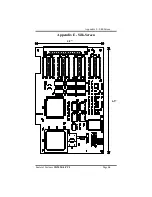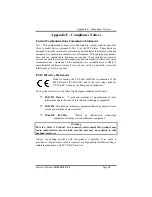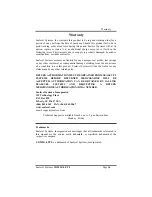
Card Setup
Sealevel Systems
COMM+4.PCI
Page
2
Card Setup
RS-485 Enable Modes
RS-485 is ideal for multi-drop or network environments. RS-485 requires a
tri-state driver that will allow the electrical presence of the driver to be removed
from the line. The driver is in a tri-state or high impedance condition when this
occurs. Only one driver may be active at a time and the other driver(s) must be
tri-stated. The output modem control signal
R
equest
T
o
S
end (RTS) is typically
used to control the state of the driver. Some communication software packages
refer to RS-485 as RTS enable or RTS block mode transfer.
One of the unique features of the
COMM+4.PCI
is the ability to be RS-485
compatible without the need for special software or drivers. This ability is
especially useful in Windows and other protected mode environments where the
lower level I/O control is abstracted from the application program. This ability
means that the user can effectively use the
COMM+4.PCI
in an RS-485
application with existing (i.e. standard RS-232) software drivers.
Switches SW1 - SW4 are used to control the RS-485 mode functions for the
driver circuit. The selections are ‘RTS’ enable (silk-screen ‘RT’) or ‘Auto’
enable (silk-screen ‘AT’). The ‘Auto’ enable feature automatically
enables/disables the RS-485 interface. The ‘RTS’ mode uses the ‘RTS’ modem
control signal to enable the RS-485 interface and provides backward
compatibility with existing software products.
Position 3 (silk-screen ‘NE’) of these switches is used to control the RS-485
enable/disable functions for the receiver circuit and determine the state of the
RS-422/485 driver. The RS-485 ‘Echo’ is the result of connecting the receiver
inputs to the transmitter outputs. Every time a character is transmitted; it is also
received. This can be beneficial if the software can handle echoing (i.e. using
received characters to throttle the transmitter) or it can confuse the system if the
software does not. To select the ‘No Echo’ mode select silk-screen position
‘NE’.
Typically, each end of the RS-485 bus must have a line-terminating resistor
(RS-422 terminates the receive end only). A 120-ohm resistor is across each
RS-422/485 input in addition to a 1K-ohm pull-up/pull-down combination that
biases the receiver inputs. Only the ends of an RS-485 network should have the
120-Ohm terminating resistor. Position 4 (silk-screen ‘T’) selects the presence of
the 120-Ohm termination resistor across the input data pins (RX+/RX-). To add
the termination select the ‘On’ position, to remove it select the ‘Off’ position.
For RS-422/530/449 compatibility set all switches ‘Off’. Examples on the
following pages describe some of the valid settings for SW1-SW4.





































